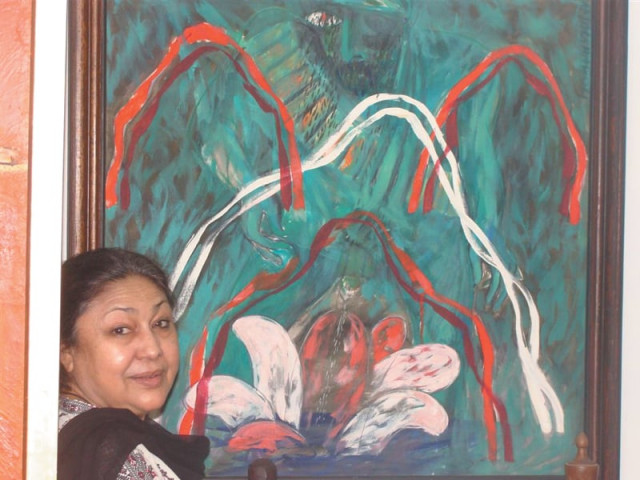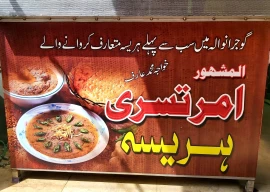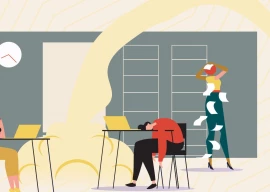
As I wait for Nahid, I study the art work adorning the walls of her studio — personal musings by Hussain and Sadequain, a sketch by Naqsh, paintings by Bashir Mirza, Tasadaq Sohail and Moeen Faruqui. There is serenity in this quiet corner, along with the memories of a bygone era of art and the hope that shaped the period those artists belonged to. Apart from the distant sound of the Azaan, there is silence as I peek out of a little window and view the sun setting across a vista of rooftops and the distant sea.
Just then, Nahid walks into the room, bringing with her the vibrancy and warmth I remember so well. No conversation on art history in Pakistan is complete without a mention of Nahid Raza; her career spans at least four decades and her paintings, which are a candid reflection of her life, have been auctioned at Christie’s — a renowned international company offering art auctions around the globe.
The last time we met was in the catacombs of a Pakistan Television studio — she was a female artist, I was the art critic and Khushbakht Shujaat the interviewer commenting on art and female artists in Pakistan. But a lot has changed since then. Governments have come and gone, PTV has been bumped down the ratings list by dozens of competing and innovative news channels and art in Pakistan has taken a new turn.
Galleries have burgeoned in every large city, completely changing the outlook of art for the country. Entrepreneurs and young professionals are now buying works of art both to signal they have arrived in life and as a safe-haven investment.
And so, Nahid and I reminisce about this change over a cup of tea, as two people who have witnessed the close-knit art family transform into the atomised world of capitalist art mongers. Nahid puts her cup down while shaking her head and mentions the word truly apt for recent times: Marketing. It is important and a young generation of artists understands this, she says.
There was scant awareness of this concept when she was a young artist.
The daughter of a journalist, Nahid, spent a peripatetic childhood moving from Karachi, to Hyderabad and Khairpur and back. Consequently, her schooling was interrupted repeatedly. She recalls that this made her more aware of her surroundings and enriched her in ways that a ‘normal’ childhood would never have.
While growing up, Nahid looked up to her two uncles — Raza, a prominent artist who lived in Paris and Ali Imam, one of the better-known personalities of Pakistani art. When Nahid finished her first year at university, Imam returned from his sojourn abroad and accepted the responsibility of heading the Central Institute of Arts and Crafts at the Arts Council in Karachi. Recognising his young niece’s talent, the maestro took her under his wing. At the CIAC, Nahid Raza started her life-long career devoted to art. She recalls how she left Pakistan in the ‘80s to study art in the US and how this had a profound effect on her work, centralising her artistic focus on her own experience as a woman — as a mother, a daughter and a wife.
Many female artists do not wish their work to be judged as ‘feminine’, but Nahid is very conscious of her gender and paints with a clear social conscience. When asked about her views on modern femininity, she surprised me when she voices her support for patience and compliance and insists on finding harmony and resisting hasty conclusions. Her role as a mother fulfills her identity as a woman today.
But Nahid’s paintings have hardly been silent on the burden of patriarchy. For those unfamiliar with the painter’s work, her first exhibition was titled “Misery”, which followed a messy divorce. For years, she used the necktie as a symbol of masculine hegemony; in her paintings it often signifies the invisible presence of a man.
But today I see a different Nahid — one who is at peace with her life, surrounded by pictures of her children and grandchildren. And this tranquility is reflected in her paintings. Her new work is, in her own words, wrapped with peace and enveloped in a milky white hue.
Ever the spiritual person, the symbolism in Nahid’s work draws from her religious beliefs. She has used the buraq — the creature is part woman, part horse — that carried the Prophet Mohammed (PBUH) to the heavens in her previous work. Her paintings now close in on an even central square. For Nahid, this is the culmination of the memory of her recent trip to Mecca, where the cubic Kaaba stands as a central stoic symbol of tranquility and peace.
Raza is also an educator of the arts. She has founded her own art institution, Studio Art, to which she devotes her time and offers her years of experience as an academician. The last time I met Nahid, her school was housed in a large building and scores of students were attending her art school. Today the school has been reduced to two small rooms, attending by a handful of students. Since property rental prices in Karachi have soared in the past few years, an art school has little chance of surviving here without the support of a government grant. She shakes her head sadly but then shrugs her shoulders to show her acceptance of this harsh reality. Remembering the zeal she had for her school when I had met her last, I experience a tinge of frustration know ing that it has reduced to this.
But at the time same time, I also felt humbled at the simplicity of Nahid’s life and her perseverance without notions of grandeur. She seems unsullied by the temptations of marketing her work. She neither pays heed to suggestions by galleries to produce more ‘sellable’ art nor does she tailor her life to suit the tastes of snooty art collectors. She continues her own love affair with art as she pleases. After all, she is part of the history of art in Pakistan. Nahid Raza’s art is a conversation of a woman’s identity in this country and her paintings over the years mark her journey as a woman, simply and unequivocally.
(The writer is a seasoned art critic, an artist herself and is the owner and designer of The Craft Company.)
Published in The Express Tribune, Sunday Magazine, February 5th, 2012.


















COMMENTS
Comments are moderated and generally will be posted if they are on-topic and not abusive.
For more information, please see our Comments FAQ